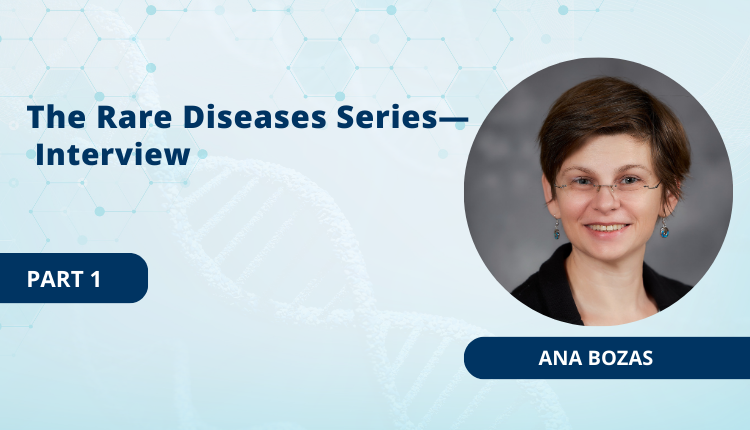In the intricate and evolving realm of healthcare, effective communication stands as a critical pillar, especially in the underrepresented and complex field of rare diseases. As medical advancements burgeon, the need for clear, concise, and impactful dissemination of scientific knowledge becomes paramount. Read on here for more information on this topic.
The spotlight of this series of interviews is on the vital role of medical communications in bridging the gap between groundbreaking research and its application, providing clinicians, patients, and other stakeholders with access to essential information. We delve into the challenges and triumphs of this endeavor, through the lens of a leader in the field who has dedicated their career to enhancing the understanding and treatment of rare diseases. This discussion aims to illuminate the nuances of medical communications and its profound impact on the rare disease community.
For the inaugural edition, we approached Ana Bozas, PhD, CMP (Director, Ipsen) for an interview and she graciously accepted. In her current role, Ana has been pivotal in spearheading the comprehensive management of scientific publications and scientific medical communication for three key rare disease products across the US Rare division. This encompasses a wide array of responsibilities, ranging from formulating strategic and tactical communication plans to guaranteeing the effective execution and dissemination of crucial scientific data to both internal and external audiences. The interview is centered on her committed work in the rare diseases domain, aiming to benefit the myriad stakeholders involved in this field.
Here’s how it went!
Interview with Ana (Part 1)
Q1. In your medical communications career, you have managed ‘conventional’ therapeutics in some broad-based indications. Since moving into the rare disease space, can you describe some of the key differences in approach you have found necessary?
“As a professional in the field of rare diseases, I am constantly navigating the complexities and challenges inherent in this unique area of medicine. The biggest challenge I face is the sheer rarity of these conditions. With so few patients worldwide, every case feels like a journey into uncharted territory. Despite their circumstances, patients with rare diseases exhibit remarkable strength and resilience. They are not just patients; they form a tight-knit community, bonded by their shared experiences and struggles. This community’s emotional depth adds an another layer to my role.
The physicians and researchers dealing with rare diseases are incredibly motivated. They are driven by a deep desire to make a tangible difference in the lives of our patients. However, the path to progress is full of obstacles. Conducting clinical trials in rare diseases is a colossal task. The enrolment process is slow and cumbersome, primarily because finding the right patients is like searching for a needle in a haystack. We often say it’s like building a plane as you’re flying it – there’s a lot of improvisation and on-the-spot problem solving, for example when not much is known about the disease in question and you have to decide how you’re measuring the success of a therapy when the clinical outcomes have not yet been clearly defined.
Data management and analytics present their own set of challenges. Having accurate information on the epidemiology of the disease (understanding the actual number of patients) is crucial, but it’s often difficult due to the rarity of these conditions. Chronic, long-term, slow-progressing diseases in the realm of rare disorders have different and more extended timelines, which complicates the picture further. Sub-analyses by patient characteristics and case-control studies, common in other medical research areas, are limited here due to the small patient populations.
In many instances, we rely on case studies, which are usually considered exceptions rather than the norm in medical research. This reliance sometimes raises the question: can we generalize these findings? In most cases, the answer is no. Each patient with a rare disease is a unique case, making generalizations almost impossible. This uniqueness is what makes rare diseases so special and, simultaneously, so challenging.”
Q2. What is your approach to effectively executing and implementing key scientific data communication for both internal and external audiences? What are the key elements you consider when developing communication materials for rare disease products, both internally and externally?
“As a medical affairs professional deeply involved in the realm of rare diseases, I face a myriad of challenges, but none is more daunting than the issue of patient identification. Imagine a disease so rare that it appears only once in a million people — this is the reality we grapple with every day. The sheer rarity of these conditions makes them not just medical anomalies but also significant challenges in terms of diagnosis and treatment.
Raising awareness among healthcare professionals (HCPs) about these rare diseases is a critical, yet incredibly complex, task. Often, these conditions present themselves in a once-in-a-lifetime case for a general practitioner or sometimes even a specialist. The journey from initial suspicion to correct diagnosis is fraught with potential missteps. A patient might be referred to a specialist, but this process is time-consuming and, sadly, it often leads to misdiagnosis and incorrect treatment. The rarity of these diseases means they’re not always top of mind, and it’s a situation where there are never enough efforts to educate and inform.
I am a firm believer in the power of communication. We must keep the conversation going, constantly educating and re-educating healthcare providers. We cannot take for granted that a rare disease will be recognized immediately or even correctly by every medical professional. To combat this, I strive to make science identifiable and approachable. It’s crucial that not just specialists but anyone in the medical field can identify potential cases. This broad-based awareness can be a game-changer in early and accurate diagnosis.
Understanding these diseases, along with their treatment and the support needed, is a continuous learning process. In order to make this science more approachable, I’ve tried adding Plain Language Summaries (PLS) in several cases. These summaries help in distilling complex scientific information into a more accessible form, which is crucial for broader comprehension and awareness – not just of medical professionals but also other professionals along the spectrum of care and even the general public.
In my daily work, I remind myself constantly that every patient matters, and every rare disease, no matter how infrequent, deserves recognition and understanding. This commitment drives me to explore every avenue, to educate, and to advocate tirelessly. It’s a challenging path, but one that holds the promise of changing lives, one rare diagnosis at a time.”
Q3. Can you provide an example of a particularly challenging communication project you’ve managed for rare disease products and how you addressed it?
“In my career, I’ve faced a variety of challenges, each requiring a different approach and strategy. The type of challenge often determines how I navigate these situations, whether they’re logistical or strategic, with the latter typically being more complex.
In one of the cases I encountered, the challenge was primarily about persuasion and direction. I had to convince a diverse group of stakeholders to align and row the boat in the same direction, especially concerning the publication of relevant data. This involved not only the usual data security concerns but also navigating a myriad of regulatory challenges. It was a delicate balance to maintain – I didn’t want to railroad anyone into a decision, particularly when the risk-benefit of proceeding needed to be decided as a team. So when I encountered significant resistance and dissent among team members (all with good reasons), I decided this may not be the best project to move forward, after all. This decision, though difficult, was crucial in maintaining trust and collaboration within the team, as well as necessary to refocus the team on our key strategic directives.
Another case presented a different kind of challenge. Here, a particular initiative had not been planned for in our initial medical strategic plan, and opinion was split on whether to support this proposed project or not. This initiative involved gathering expert consensus advice from key opinion leaders in the field for monitoring and screening rare diseases during the pandemic. Despite some initial internal skepticism, I believed in the importance of this project and supported its development. Eventually, it was not only implemented but also published and read by others, which was a great help for people seeking guidance on practical steps during a time of great uncertainty.
These experiences taught me the importance of looking for a win-win situation in every challenge. It’s not just about achieving one’s goals but doing so in a way that benefits all parties involved. This approach has helped build stronger, more collaborative relationships and has led to more sustainable and effective solutions.”
Q4. How do you ensure that the communication of scientific data complies with regulatory and ethical standards, especially in the context of rare diseases?
“In my professional experience, especially when handling sensitive patient data, I’ve learned that while there are challenges, none are insurmountable if we adhere to certain key principles and guidelines. The primary concern, and one that is non-negotiable, is patient privacy. This is a cornerstone of our practice and shapes how we handle all data and communications.
In the realm of medical research and publication, particularly when dealing with case studies or case series, there’s always a potential risk of unwittingly revealing enough details to identify the patients. This risk is heightened due to the detailed nature of these reports. As physicians and researchers, we (the drug manufacturers) and the medical community act as the safeguards of our patients’ confidentiality. We are meticulous in ensuring that no personal data is included and inadvertently disclosed. This responsibility is something everyone in the field understands and respects – these are the guardrails that are well-known and universally acknowledged.
Another crucial aspect of our work is the integrity of the information we share and publish. We take great care to craft accurate scientific communications that avoid making broad statements that can be misinterpreted or misused. Each piece of data, each finding, and each conclusion must be presented with precision and accuracy. In our communications, we steer clear of making claims that are not backed by solid evidence.
When it comes to data analysis, the principle of not cherry-picking data is paramount. Every dataset has its nuances and complexities, and it’s our duty to represent these faithfully. Instead of selectively choosing data that supports a preconceived narrative, we focus on sub-analyses that can provide deeper, more meaningful insights, and test multiple assumptions to ensure that our initial assumptions do not affect the results of the study and to try to isolate potential confounding factors. This approach not only upholds the integrity of our research but also ensures that the conclusions we draw are robust and reliable.
Ultimately, in all our endeavors, we are guided by the dual principles of safeguarding patient privacy and maintaining the highest standards of data integrity. This approach has not only helped us overcome challenges but has also fostered trust and credibility in our work. It’s a fine balance, but one that is essential for the advancement of medical science and the betterment of patient care.”
I am sure you enjoyed reading this. In Part 2, we talk more about her methods, strategies, and experiences in this field as well as the important geopolitical changes in rare disease landscape. Coming soon.
Disclaimer: The final content has been processed using AI for note-taking efficiency; however, the initial interview and all insights are derived from a human source.
Author:
 Dr. Anupama Kapadia
Dr. Anupama Kapadia
General Manager, Enago Life Sciences
Connect with Anupama on LinkedIn

